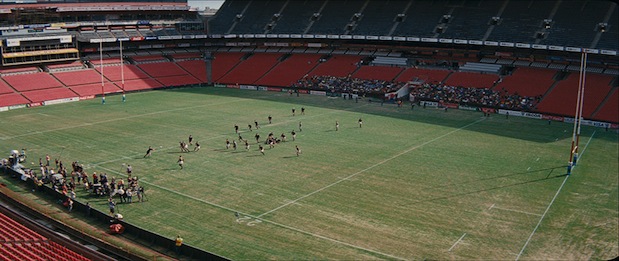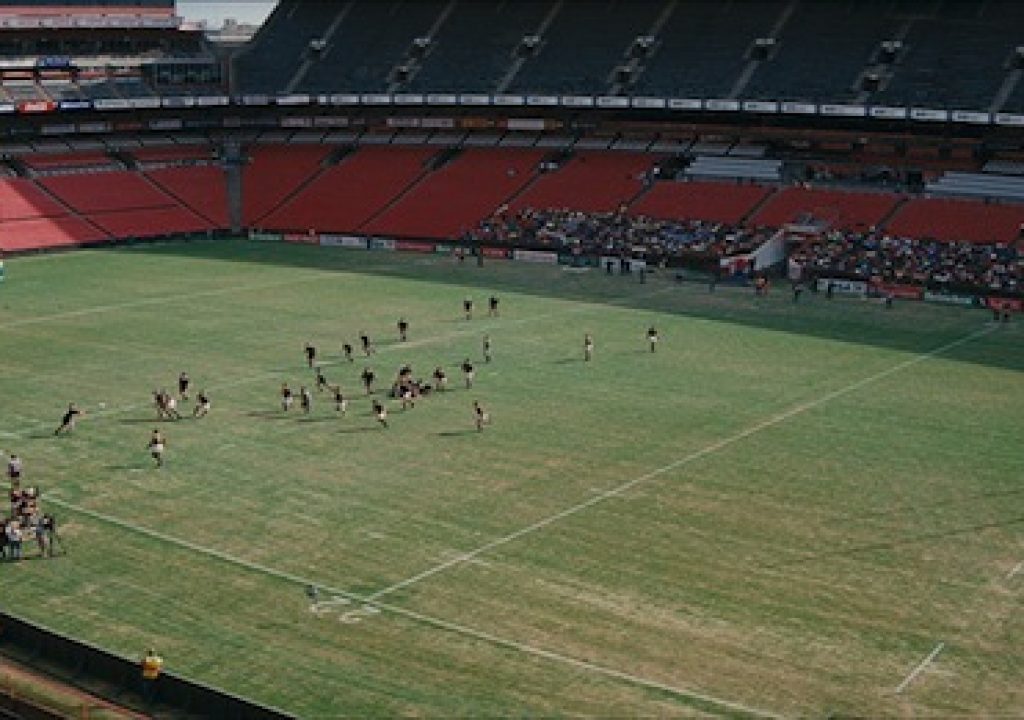
Original plate of stadium (top of page). Stadium filled with synthetic crowd (bottom of page).
Photos courtesy of Warner Bros. Pictures and CIS Vancouver.
Awash, like everyone else, in “Avatar” madness (see here and here the two parts of my recent conversation with camera guru Vince Pace about the stereoscopic camera technology developed for that movie), it’s been hard to ponder the fact that there are, in fact, other things going on in the world of visual effects. With effort, I forced my mind to examine the concept, and have come to realize that one of the quietest, yet significant, visual effects developments in the last 12 months came out of a feature film that is getting all sorts of notice, but none for its visual effects. I’m talking about Clint Eastwood’s “Invictus”-about as traditionally made a film as you are likely to find, and a film not even on the short list for Academy Award consideration in the visual effects category this year.
Still, a chat I had recently with Eastwood’s visual effects man, Michael Owens-visual effects supervisor on all Eastwood’s films that utilized digital effects since “Space Cowboys” (2000)-contextualized for me the fact that there is, in fact, an important role for visual effects in the world of so-called “traditional” filmmaking. Owens explained the crucial, and growing, role that so-called “invisible effects” are playing in the world of cinema at precisely the same time that such tools are permitting James Cameron and his cohorts to revolutionize big-budget effects’ films. Owens points out that “Invictus” has a surprising 600 digital effects’ shots in it, all created at CIS Vancouver, with help from its sister facility, CIS Hollywood, and a large group of boutiques across the world contributing rotoscoping and match-moving assistance.
The bulk of that work was hardly revolutionary from a conceptual point of view, as compared to, well, “Avatar.” It largely involved digital crowd creation and massive rotoscoping work to replace an empty stadium background with synthetic crowds and backgrounds for the film’s key scenes involving the South African rugby team’s march to the World Cup in 1995. Filmmakers also created an entirely synthetic United Nations General Assembly room for a key scene, among other digital touches. But, the biggest single visual effects challenge in the film was clearly the digital stadium and crowd work. Indeed, Owens declares with confidence that, believe it or not, “Invictus” is “the largest rotoscoping job of all time for cinema.”
That’s hard to prove, I suppose, but interesting that the movie might even possibly contend for such a niche distinction. Among other things, it’s interesting because it illustrates how willing the longtime rock of traditional filmmaking-Clint Eastwood-has become to utilize digital tools and techniques, and experiment with them, compared to what one might think given his reputation and typical meat-and-potatoes results with movies like “Invictus.”
“On ‘Invictus,’ one of the main tasks was to put 60,000 people into rugby stadiums,” Owens explains. “We only had a few extras on set, and therefore, to be able to create those crowds any time we show play in a rugby match, the entire background had to be replaced. We shot in real stadiums, but had to replace everything but the players in order to fill those stadiums convincingly. The only way to do that is frame by frame rotoscoping, separating the players from the stadium. Then, we had to synthetically re-create the stadium and put our synthetic crowds into the synthetic stadium. We completely replaced everything from the grass up in for practically every shot involving rugby play.”
The typical notion of putting up some kind of a gigantic blue screen in order to do digital extractions of the players in the foreground, of course, was out for both logistical and creative reasons. Logistically, it would have been tough to do in facilities the size of the stadiums the production filmed at in South Africa anyway, and besides, Eastwood traditionally wants little or nothing to do with blue screen, green screen, or anything else that will slow down or otherwise inhibit his legendary rapid shooting pace. Thus, “Invictus” evolved into one hell of a gigantic roto job.
The basic approach, of course, evolved out of work Owens’ team did on Eastwood’s “Flags of Our Fathers,” in which backgrounds had to be replaced or augmented with CG location extensions to create the legendary look of the island of Iwo Jima, and to combine live action with CG shots of the gigantic Allied armada assaulting the island. That film was Eastwood’s largest foray into visual effects since “Space Cowboys,” and played a central role, Owens and other Eastwood collaborators insist, in convincing the legendary filmmaker that his “traditional” process can, in fact, merge seamlessly with digital filmmaking tools and techniques.
“The key was to keep a management team, based at CIS Vancouver, and counting on that team to manage the other facilities that were doing all the roto and the other work,” says Owens. “To populate and replace all the elements of the stadium was the main task, and we realized we could do it without blue screen because we had done it on ‘Flags of our Fathers.’ It’s tedious, but definitely the right thing to do. This approach lets Clint stay in his mode and his cameraman (Tom Stern) stay in his mode (during production)-working as though it were a non-effects’ movie. The camera movement and everything else feels just like any other (Eastwood movie). I get a lot of work to do later in post to replace it all, but Clint is very understanding about waiting for the shots, and is now well used to using animatics and storyboards (in the evolving cut) while he waits for them. He has learned to trust the process and the results.”
Massive Pipe
Of course, the stadium/crowd work involved a lot more than just roto work-unique, believable crowds filled with rugby fans had to be built. Owens and his collaborators, including CIS visual effects supervisor Geoffrey Hancock, are particularly proud of the Massive crowd simulation pipeline they designed to achieve this end. Once again, they suggest that their approach helps take the art and science of crowd sims just a bit further down the road than it was previously. As with most high-end crowd work in Hollywood these days, the rugby crowds started with New Zealand’s Massive Software-a tool launched to prominence with the “Lord of the Rings” trilogy and also used in Cameron’s “Avatar.” However, in the case of “Invictus,” filmmakers blended their Massive pipe with their Houdini and Maya pipes to make the process just a bit more powerful, according to Owens and Hancock. Owens, in fact, insists they took the concept “to a whole other level of complexity of character movement, demographics, and costumes, among other things.”
Hancock explains that end result was built around the production’s desire to take advantage of each software tool’s individual strength inside a single pipe.
“Massive is an excellent motion choreography and simulation tool, but it can be cumbersome to make extensive animation changes late in the pipeline,” says Hancock. “Houdini has an excellent non-destructive procedural architecture, and Maya is a great modeling and rigging package. What we did was write a custom plug-in in-house that allows Houdini to communicate with Massive. That way, our thousands of motion-capture clips could be edited and controlled in Massive, saved into pre-simulated caches for various emotions, and then passed into Houdini for easier control and quicker iterations in layout-mixing and matching all the demographics, appearances, and emotional responses of individuals and groups. This system allowed for late in the pipeline changes to be made to any aspect of a character without lengthy re-simulations required.”
Digital Makeup
Owens emphasizes that Eastwood’s willingness to turn to his digital effects unit for such solutions didn’t end with the stadiums and crowds in “Invictus.” He points out that Eastwood, during the making of his last film-“Gran Torino”-stumbled into the joys of digital makeup and prosthetics and was a full-blown convert by the time “Invictus” rolled around. Indeed, Owens points out that films like “Gran Torino,” which had about 100 digital effects shots, and “Invictus”-neither of which has, or wants to have, any sort of a visual effects’ profile as far as movie-goers are concerned-have played important roles in evolving Eastwood’s thinking about problem solving in post more efficiently, without sacrificing the advantages and comfort of his straightforward production approach.
In the case of “Gran Torino,” it all started with a cut-up hand and simple tears rolling down the cheeks of the character played by Eastwood. Owens’ digital solutions for these requirements satisfied Eastwood so much that he decided to liberally employ them in “Invictus” to show physical wear and tear, cuts, bruises, blood, and grass stains all over the faces and bodies of the film’s rugby players.
On “Invictus,” this work was dubbed “the blood and guts effect,” according to Hancock. It was a much bigger job than on “Gran Torino,” of course, and required extensive tracking work since the players are constantly moving and interacting, but Owens feels the solution “worked great” for Eastwood. To hear Owens discuss the evolution of the technique and its importance as a new tool in the Eastwood filmmaking arsenal, click below:
Invictus- “The Largest Rotoscoping Job of All Time” from ProVideo Coalition on Vimeo.
Digital Acquisition?
Eastwood has also joined the digital intermediate express in recent years, starting with “Flags of Our Fathers,” and also utilized prosumer-level HD cameras for that project to capture POV shots illustrating the chaos of battle. (You can read my Millimeter magazine coverage of that project and those developments here.) Eastwood’s colleagues, including Owens and cinematographer Tom Stern, tell me he has had them routinely testing digital camera of various flavors for the last couple of years as part of an ongoing investigation into when, if ever, the ultimate traditionalist will dive into all-digital filmmaking. Eastwood is greatly attracted, they say, to the notion of using small, light-weight systems while eliminating the need for frequent reloads, since those two concepts fit his rapid-fire production philosophy nicely. On the other hand, as Eastwood’s recent successes illustrate, things are working just fine for the filmmaker, and so, he has not made the move … yet.
Owens, for one, thinks it is only a matter of time before Eastwood does give digital acquisition a go, however,
“Absolutely-we’ve already sampled just about every kind of camera that exists, consumer and professional,” says Owens. “We shot (those combat scenes in ‘Flags of our Fathers’) 25p PAL and got some amazing angles and shots. So we’ve been exploring that stuff for several years now. Film is just so familiar to Clint and (Tom Stern)-it’s a no-brainer they can make great movies with it. But if it were the right project, and Clint sees it becoming easier to shoot digitally, then in that case, I have no doubt he’ll do it eventually.”

